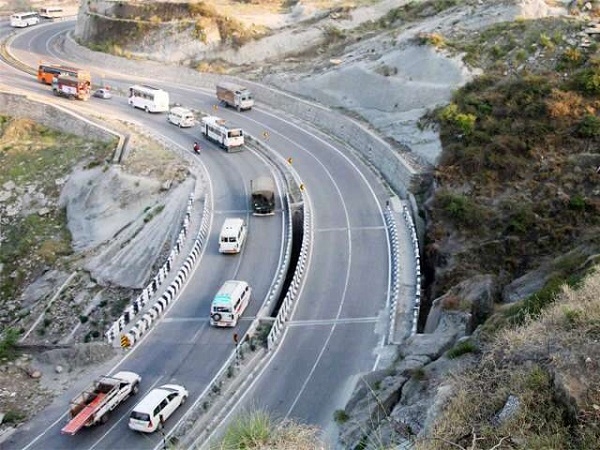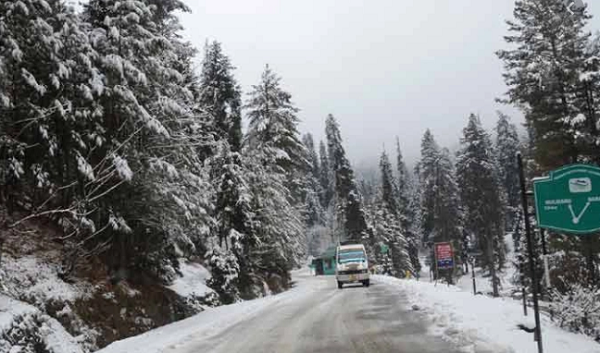Changing Infrastructure Landscape of J&K and Laddakh
18 Aug 2020 12:53:41
This August 5th Country celebrated two major events signifying the strong democratic and constitutional process in the history. First on 5th August Hon PM laid the foundation stone for a magnificent Ram Temple at Ayodhya. The SC verdict has paved a way for building a grand Ram Temple at the birth place of Lord Rama. The other significant event is the first anniversary of the amendment of Article 370 of the Constitution. The entire nation along with Jammu and Kashmir (J&K) and Ladakh is celebrating and rightly so. It is an event that deserves to be celebrated as it marks complete integration of the state of Jammu and Kashmir into the Union of India. The ‘special status’ the state enjoyed in reality had favoured only a few powerful families rather than the people of J&K. The family-controlled political parties took turns to rule the state but the real sufferer was the governance and people of J&K. In the last more than 70 years the state has been waiting for all weather connectivity. The forces still have to pile up their stocks for winters during summer. The infrastructure that can unleash economic freedom and sea of opportunities in tourism was still a distinct dream.
A strong physical infrastructure is a catalyst of growth and development of a region. That is why roads and highways are considered as the arteries of a nation; Arteries that facilitate movement of people and goods and bring prosperity. The Modi government since it came to power in 2014 has unleashed the new era of Multifold development in the highway sector in the state. Last six years have seen pace of infrastructure growth that could not be seen in last 30/40 years. The government was surely aware of its enhanced responsibility to continue with that pace particularly after the bifurcation.

Jammu and Kashmir and Laddakh, with its difficult terrain, extreme weather, and security risk, poses a significant challenge not only for the engineers but also the policymakers. The past few years have seen a dedicated focus of the Ministry of Road Transport and Highways on development of highway infrastructure in the region. Various agencies like National Highways Authority of India (NHAI), National Highways Infrastructure Development Corporation Ltd (NHIDCL), Border Roads Organisation (BRO) and Public Works Department (PWD), who have undertaken many projects of economic and social importance to improve all weather connectivity in the region. The strategic importance and impact of BRO’s work was witnessed by all during the recent developments in the border region. While the BRO mainly undertakes projects of critical strategic importance, NHAI and NHIDCL are working on several projects which are important for socio-economic development of the area.
Whether its connectivity between the capital cities of Jammu and Srinagar and to Leh in Ladakh or 4-laning of the main arterial Srinagar-Jammu-Lakhanpur (NH-44) highway forming part of the North-South corridor project. These on-going projects in the union territory are changing the landscape of infrastructure in the state. The completion of the ambitious Chenani-Nashri Tunnel – the longest road tunnel (9KM) has been a major boost to the connectivity between Jammu and Srinagar, giving relief to commuters from snowbound Patnitop range improving all-weather connectivity between the two capitals. The other major tunnel under construction, Qazigund-Banihal located in Pir Panjal range expected to be completed in March 2021, these two tunnels would reduce the travel distance by about 50 Km. The savings in fuel and time is expected to be equivalent to Rupees 27 lakh per day. Apart from above two long tunnels, there are 9 more short tunnels are under construction between Jammu to Srinagar having 3.9 Kms equivalent 4-lane length at critical locations to avoid landslides prone stretches, ensure safety of commuters and all weather traffic worthiness of Jammu Srinagar National Highway. The list of projects is long enough to occupy the entire space of this article, but to mention few; economically important Greenfield ring roads for Jammu and Srinagar. These ring road projects will contribute in the industrial development of the cities, decongest the cities, reduce the travel time and pollution, and help in generating substantial economic activity in the periphery of Jammu & Srinagar City.
On the other hand, development of NH144A, NH 244 and other highways of strategic importance with an estimated cost of about 11,812 Crore Rupees. The Jammu-Akhnoor Section of NH-144A is a vital defence road and amongst the busiest roads of the state, which connects Rajouri and Poonch to the rest of the country. At present, the Jammu-Akhnoor road is the only way to reach international border at Marh, Kanna Chakk up to Chicken Neck in Akhnoor which is the most congested road in Jammu. After widening, the project road will not only decongest the traffic of Jammu city and enhance the safety of the road users but will also ease the movement of defence vehicles heading along the international border. The Chenani-Sukhmahadev project envisages the connectivity to backward and rural areas of Udhampur district and ensuring safe connectivity to Doda. Seven new projects worth 8,599 crore Rupees are in the bidding stage and are expected to be awarded during the current year. Build-Operate-Transfer project worth 2,378 crore Rupees are also at different stages of awards.

The importance of current road development projects in UT of J&K cannot be completed without special mention of two key tunnel projects in the region: Z-Morh with budget of 2500 crores and Zozila Tunnels with expected expenditure of more than 6000 crores. These tunnels form the all-weather connectivity between Srinagar, Kargil and Leh which is an important road from national security perspective. Sections of the road lie in identified avalanche sites, with avalanche triggering and accumulation of snow to about 40 feet, and therefore remains closed between November to April. The Z-Morh project consists of 6.5 Km of tunnel. The Zozilla Tunnel is a 14 Km stretch between Baltal and Minamarg and will be Asia’s longest road tunnel to be built at an altitude of 11,578 metres above sea level. Upon completion, it will reduce the total travel time by 2 hours.
Many of these projects were envisaged and planned earlier, however, the abrogation of Article 370 last year, has seen an invigorated push towards initiation and construction of these projects. The political integration of the region has also seen an increased interest from developers and contractors for taking up these projects. Further, the development of Delhi-Amritsar-Katra Green Expressway Project, which will reduce the Delhi-Katra distance by 50 Km, can prove to be an important factor in economic integration with the national capital. The budgeted expenditure for this Green Field Expressway is more than 30 thousand crores. Besides reducing the travel time and thereby transit wastage for farm products from the valley, it can also provide access to more remunerative markets. These highway projects will not only improve the road infrastructure within the Union Territory but also generate significant jobs both during the construction and operation of the projects. The secondary effect on industrial growth, increase in tourism, easier pilgrim movement and overall economic prosperity will be greatly impacted due to these and other future projects.
Big and bold decisions are proven right only if they are backed by right intentions and commitment. On the anniversary of abrogation of article 370, government’s commitment of Investment of more than 1 lakh crore in the Highway sector in the UT of J&K and Laddakh gives hope and confidence that the change that is envisaged by Hon PM is surely coming and at such pace that we have not seen before.